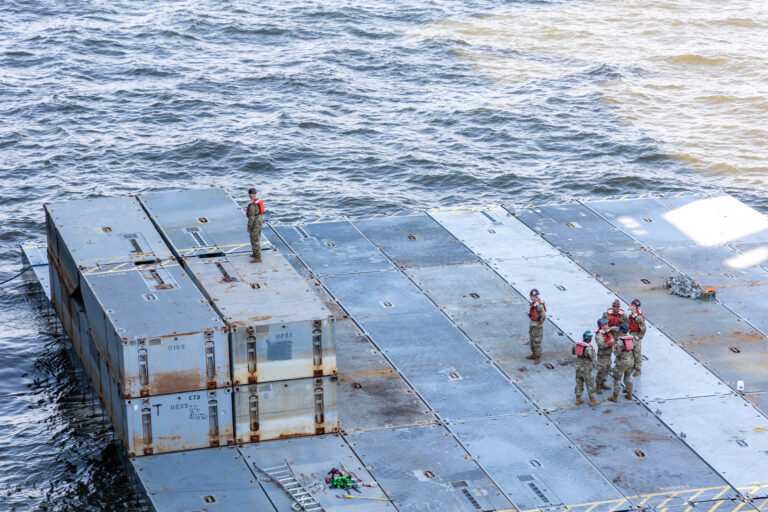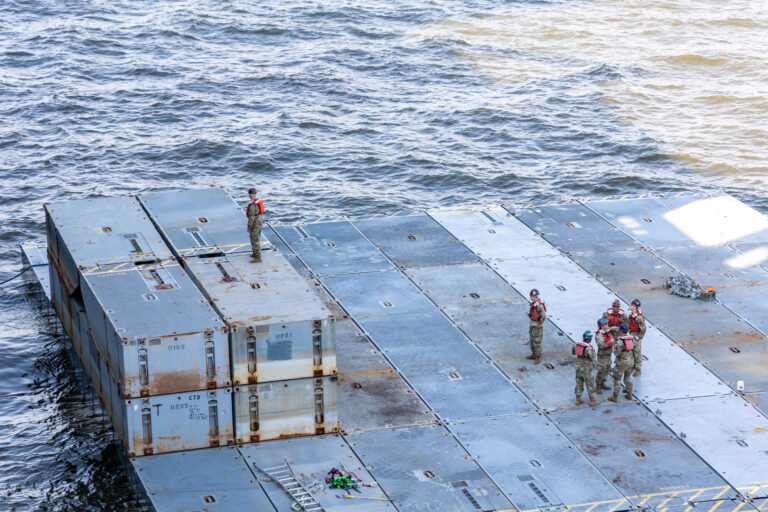
The U.S. military has officially ended its Gaza aid pier mission after operating the makeshift pier in stop-and-go fashion for weeks.
Vice Adm. Brad Cooper, the deputy commander of the U.S. Central Command, announced the end of the humanitarian pier mission in a Wednesday, July 17, statement.
From the time the pier went into operation in mid-May to its last day anchored to the Gazan shoreline, it had operated for approximately 20 days, and enabled the transfer of 19.4 million pounds of food, medical, and other humanitarian supplies.
The Pier’s Operational History
President Joe Biden ordered the construction of this humanitarian supply corridor in March, after a deadly Feb. 29 incident in which dozens of people were injured and killed waiting for an overland delivery of food supplies. Conflicting reports emerged after the Feb. 29 incident, with the Israeli military reporting most of the people injured and killed in the incident were trampled as they rushed a supply convoy. Other accounts alleged Israeli forces fired on the crowds as they ventured close to a nearby Israeli military checkpoint, and that this also contributed to a stampede. The Israeli military has acknowledged firing toward a crowd near the supply route.
The U.S. military and Israeli partners anchored the aid pier to the Gazan shore on May 16. From there, the pier operated for about eight days before stormy seas scattered U.S. Army vessels supporting the structure and damaged the pier.
CENTCOM removed the pier to the Israeli port city of Ashdod and re-anchored it on June 7. By June 14, the U.S. military announced they again relocated the pier to Ashdod to wait out rough sea conditions.
CENTCOM anchored the pier to the Gazan shoreline for a third time on June 20. By June 28, CENTCOM had again removed the pier, to wait out another round of bad weather.
Last week, National Security Advisor Jake Sullivan announced CENTCOM would soon end the pier mission, but gave no specific timeline. On July 12, the Pentagon announced a failed attempt to re-anchor the pier but left their future plans for the pier unclear.
With his Wednesday announcement, Cooper indicated that the pier mission was officially over. CENTCOM would not make a final effort to briefly re-anchor the pier to process any more aid.
Pier Operations Questioned
The U.S. military faced numerous questions about the pier mission during its two months in action.
Israeli forces landed a helicopter near the pier on June 8, during a deadly raid to rescue Israeli hostages who’d been held in Gaza since Oct. 7. Gazans and some international observers raised questions about the proximity of the helicopter to the pier during the operation, and whether the pier was being used to support military operations rather than purely humanitarian efforts.
Pentagon officials denied the aid pier had supported the Israeli rescue mission, but suspicions have persisted. By June 10, the United Nations had confirmed its World Food Program had suspended operations through the pier while it reviewed whether the pier was being used for military purposes.
U.S. military officials have also faced questions about whether the pier operated as advertised.
Prior to the start of the pier operation, the U.S. military repeatedly said the structure would be able to process up to 90 truckloads of supplies each day, and eventually build capacity for 150 truckloads a day. After the pier began operations, U.S. military officials switched to weight rather than truckloads as their primary delivery metric, leaving unclear if the pier was handling the maximal level of traffic. Reporters had repeatedly asked Pentagon spokesman and Air Force Maj. Gen. Pat Ryder to clarify the weight to truckload conversion at a May 21 press briefing, but he did not provide a precise answer.
Questions have also centered on the aid distribution within the Gaza Strip. Trucks passing over the aid pier had delivered aid to a marshaling area further inland, guarded by Israeli forces. From there it’s been unclear how much of the aid has left the marshaling area for wider distribution among the general population in the embattled territory.
On June 27, the inspectors general for the Department of Defense and U.S. Agency for International Development (USAID) announced they would both review the pier mission and the efforts to distribute aid from the marshaling area.
Continued Aid Challenges
Cooper said ships carrying humanitarian aid by sea will now offload at Ashdod. From there, they will be carried overland by truck into the Gaza Strip.
While trucking aid overland is the most cost-effective delivery method, they can still face disruptions.
Reports have emerged in recent months of Israeli activists intentionally blocking and looting aid delivery convoys. Those activists contend that Israel’s enemies in Gaza are taking control of the aid after it enters the embattled territory, and that blocking the deliveries is necessary to defeat their enemies.
Last month, U.S. government announced sanctions against one of these Israeli activist groups blocking overland aid convoys, Tzav 9. The Biden administration has urged the Israeli government to ensure aid can continue to flow into the Gaza Strip.
The actual number of supply trucks reaching the Gaza Strip is unclear. The United Nations Relief and Works Agency for Palestine (UNRWA), has said about 500 truckloads of supplies daily are necessary to sustain the Gazan population.
As of July 15, UNRWA had reported some 25,188 trucks of supplies have reached the Gaza Strip in a 268-day period since Oct. 21, two weeks into the current Israel-Hamas conflict. That amounts to about 94 aid trucks reaching the embattled territory daily; less than a fifth of the projected need. This calculation does not account for supplies brought in by sea or delivered by airdrop.
The United Nation’s latest famine assessment, known as the Integrated Food Security Phase Classification (IPC), states 96 percent of the Gaza Strip’s population (around 2.1 million people) face “high levels of acute food insecurity through September 2024.” The IPC assessment puts the entirety of the Gaza Strip in its Phase 4 “Emergency” classification, the second-most dire phase of food insecurity. This same assessment finds about 495,000 people (around 22 percent of the population) is in the IPC Phase 5 “Famine” classification.
This article was originally published by FreeBase News and is reprinted with permission.
American Military News Rephrased By: InfoArmed
